Leo Villareal’s artistic practice is an exploration of the fundamental elements that underpin complex systems. Through his work, he delves into the essence of systems, dissecting them to their most basic components such as pixels or binary code. It’s a journey that starts from simplicity, from the foundational building blocks, and gradually evolves into intricate, dynamic compositions.
Central to Villareal’s artistic inquiry is the fusion of space and time, where forms morph and interact, echoing the dynamic rhythms of life itself. Inspired by the pioneering work of mathematician John Conway, particularly his exploration of cellular automata in the Game of Life, Villareal crafts digital organisms that evolve and grow in unpredictable ways.
Chance plays a pivotal role in Villareal’s creative process. Embracing randomness, he sets the stage for emergent phenomena to unfold organically, devoid of predetermined outcomes. Through meticulous curation and manipulation of sequences, often employing basic arithmetic operations, Villareal orchestrates a symphony of light and motion.
Harnessing custom software, Villareal manipulates parameters like opacity, speed, and scale, infusing his compositions with a sense of fluidity and spontaneity. Each artwork becomes a manifestation of code, a luminous expression of mathematical beauty.
Villareal’s oeuvre extends beyond traditional gallery spaces, manifesting in monumental site-specific installations around the globe. From the ethereal Light Matrix illuminating the Auckland Theater Company to the pulsating Volume at the Dallas Cowboys World Headquarters, his works redefine urban landscapes, inviting viewers to engage with the interplay of light and architecture.
His portfolio boasts prestigious commissions, including the iconic Bay Lights adorning San Francisco’s Bay Bridge—a breathtaking testament to the marriage of art and technology. In April 2021, Villareal unveiled Illuminated River, a monumental project uniting nine bridges in central London in a dazzling display of public art.
With works housed in esteemed institutions such as The Museum of Modern Art and the National Gallery of Art, Villareal’s legacy as a pioneer of illuminated art is firmly cemented. Through his relentless exploration of light, code, and chance, he continues to push the boundaries of artistic expression, offering glimpses into the sublime complexity of our interconnected world.
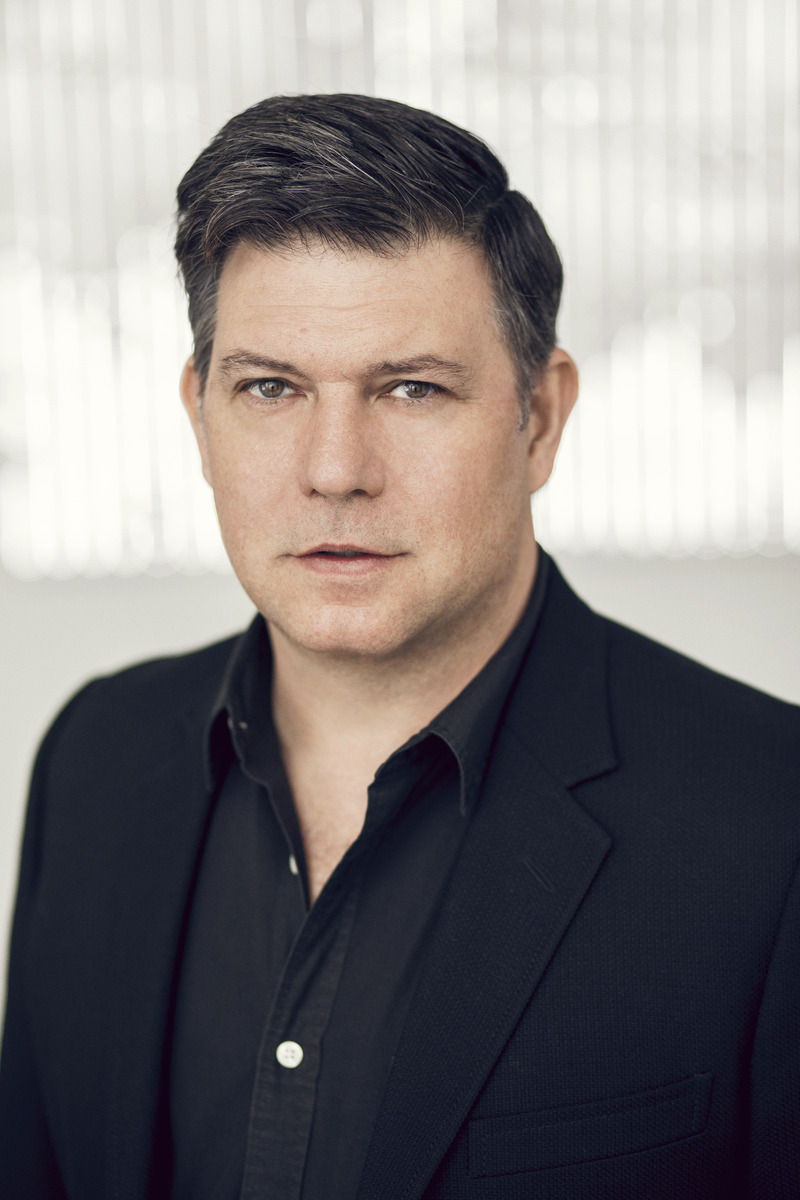
An Interview with Leo Villareal
By Carol Real
Leo, when did you realize that “stripping systems” to their core was your artistic calling?
It was in college. I was studying at Yale as an undergraduate, and I realized then that I wanted to be an artist. So, I started with installation sculpture. I graduated in 1990, the year that Photoshop first came out, and I was very intrigued by it, as you could digitally edit images. Additionally, there was a buzz about virtual reality for the first time, which caught my attention. I wanted to learn more, but it was still early days. I ended up at NYU for two years in the Interactive Telecommunications Program for graduate school. However, there was no industry at the time; the best job you could get was making CD-ROMs. It wasn’t like it is now or has been since. Despite this, I was interested in being in New York City and learning about technology.
During my two years of grad school from 1992 to 1994, I loved going to galleries in SoHo and I gradually realized I wanted to use some of these technical tools, but I didn’t know exactly which ones. Then I got a job in Palo Alto at a research lab, so I moved to California and became a member of the research staff at a think tank called “Interval Research.”
Finally, in 1997, I made my first light sculpture, almost by mistake. I found the materials and I thought, “Whoa, this is something very powerful.” That’s the door that opened for me. In 1998, I established my studio in New York City in Chelsea. I started making my work, gradually participating in group shows, then solo shows, and eventually public artworks.
You’ve mentioned John Conway’s work with cellular automata as an inspiration. How has his mathematical exploration influenced your art?
Well, the Game of Life is the cellular automaton program that he created, and it’s very simple. There are very few rules, but out of those simple rules, very complex patterns emerge. So, you could look at them and think it was something biological, something very small under a microscope, or it could be something in the cosmos but very much alive. It was interesting to me—how can code be alive with such simplicity? I thought, “Wow, this is very intriguing,” and I started to think of my own rules and how I could create my own inspired by Conway. That was the start of a long journey, and I still think about these things today. Rules and systems underlie all my work. It started with Conway but grew to learn about Newton’s laws and how I could apply those rules to control my artwork with those parameters. Rules and systems are an exciting framework for me to interpret other artists’ work as well. I created an artwork, Liminal Gradient, thinking about the algorithmic underpinnings I see in Mark Rothko’s work. I often think, “How does this work?” and break it down to work with it through code. So, I would say art has always been a big influence. Other artists’ work has influenced the development of the rules and structures I employ in my work, and my response to them. Also, things in nature, like the movement of water, a sunset, or other natural phenomena, influence my work. When I think about these things, I try to break them down into code. I’m not using photography or video to capture nature; instead, I recreate the movement of water with code.
I think it’s essential that it’s not photographic or sampling from nature; it’s recreating it from underlying rules. What I’ve found is that you can distill complicated things in nature into code. It’s quite exciting because these seemingly complicated things turn out to be fairly simple from the code perspective. I like to play and improvise when working with things. I’m interested in making discoveries, engaging in concepts of emergent behavior and artificial life, and trying things to see what happens. I wait for that moment of surprise and then capture it. I’m also inquisitive about how natural phenomena work. Once I understand how they work, I explore how to manipulate them. For instance, if I understand how to make water, I think about how to make it do specific things or create new hybrid forms that resemble the cosmos, or a flower. I combine these forms in ways that provoke human responses similar to our reactions to nature. I can create a sense of awe or wonder with synthetic means using code and LEDs, and somehow evoke human and universal responses.
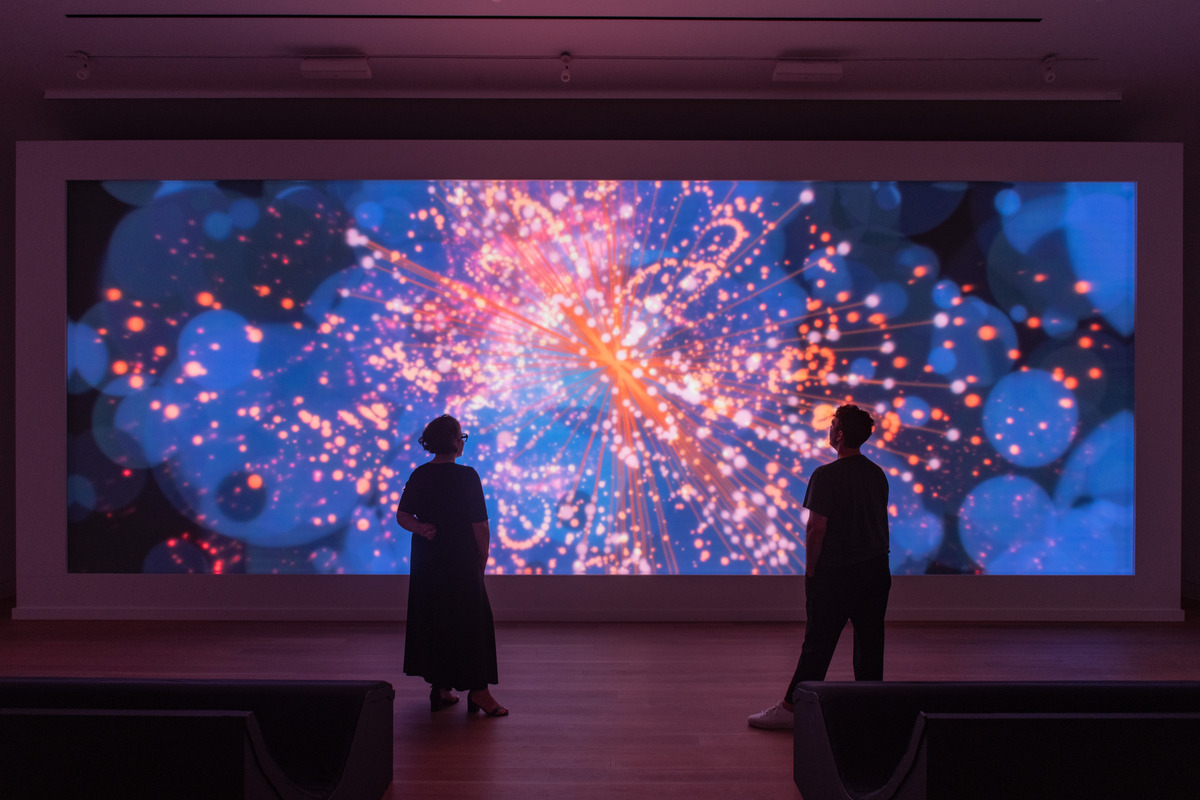
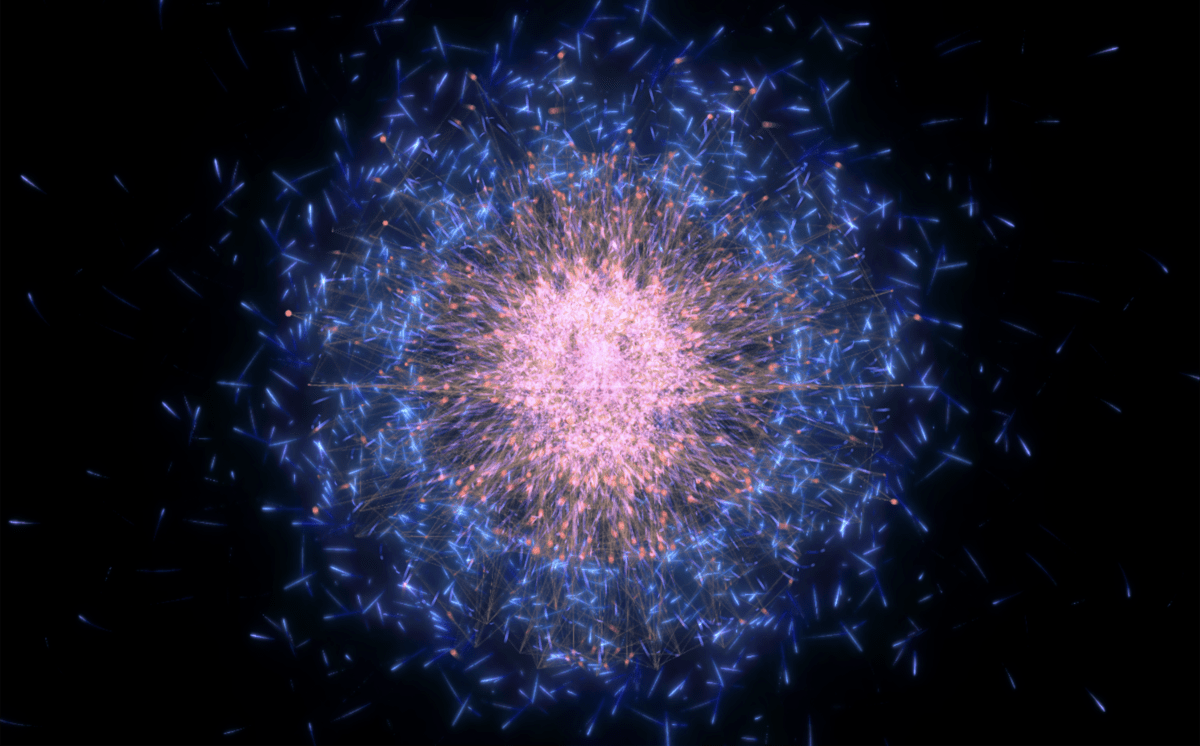
This process is integral to the question that I intended to discuss regarding addition, subtraction, and multiplication and how they transform your initial ideas into your final work.
I would describe my earlier pieces as almost like single-channel sound pieces, a simple arrangement of 16 strobe lights blinking off and on, zero or one. Over time, my work has become much more layered and complex, incorporating various elements in a more intricate composition. I drew inspiration from artists like Roy Lichtenstein and his explosion sculptures with dot patterns and layers, and Andy Warhol’s silk screening layers of things on top. Today, instead of silk screen patterns, it’s the video wall surrounded by grids of light and LEDs. I use similar materials used in advertising, like those in Las Vegas or Times Square, but I remove the advertising message, creating completely abstract work. There are no images or text; it’s about creating something open-ended. Viewers are left with the seductive, powerful visual quality of technology without the push of advertising. It’s up to the viewer to decide what they see, and there’s always a sense of mystery; it never resolves. I play with enough information to trigger certain responses, but then things start to shift. I’m interested in ambient space, similar to what Brian Eno does with sound, creating a tone.
Things like The Bay Lights activate the entire bay in San Francisco. They’re used in a soft way, tuned precisely not to overwhelm. They are meant to be something elegant, not demanding one’s attention like a TV in a bar or restaurant. I aim to create things that have a presence but are not overwhelming. I think that’s important.
So, can you walk us through the decision-making process for selecting compelling sequences? And I know you use pixels and binary code, right?
I’m interested in improvisation. Part of what I do—many people think you can’t improvise with code because either the code is going to run or it’s not going to run. However, it turns out you can, and you can try things. I was in a show at the Hirshhorn and LACMA called Visual Music, curated by Kerry Brougher and Jeremy Strick. The show was all about synesthesia, remapping the senses, and starting with artists like Wassily Kandinsky. It explored alternate histories of abstraction, including the ’60s light shows or special effects by Douglas Trumbull in 2001 or Oskar Fischinger and others using different media.
This translation of different senses into one another is quite interesting. What I would say is I’m making instruments that have a visual aspect. Sometimes I use sound, but it’s primarily a visual thing. I think the reason why they wanted me in that show is that my compositional methods were very much like what a musician might use.
I’m constantly trying things. I have certain ideas of what might work, but I don’t know. I have to sit there and look at it, spending time with the artworks, waiting for these compelling moments to happen. Then I capture those moments. There’s an aspect of recording when that happens. I capture that sequence, and then those become the building blocks for the pieces. All of these things get assembled into another progression. But it’s hard to know when it’s done because I feel like when I get to the same place from multiple directions, I start to get closer to what the piece is. So you have to be comfortable with that.
When I’m working on a site-specific piece like The Bay Lights, I’ll be sitting in front of the entire Bay Bridge with my laptop, trying things and experimenting. Everyone in San Francisco or anyone who can see the bridge can watch this trial-and-error process. Literally, hundreds of thousands of people can be watching this process of me investigating and experimenting. It was interesting to reveal all the glitches, bugs, and things that didn’t happen. However, I think everyone in the Bay Area was very tolerant of this idea of debugging and revealing the process.
It’s interesting for me to go to different places like London, sitting on the banks of the Thames with my laptop when I was sequencing the nine bridges of Illuminated River, dealing with rain or fog or whatever’s happening. There are a lot of environmental factors we’re struggling with. But for me, it’s about site specificity and being present in these locations, seeing it with my own eyes, tuning and adjusting it like an instrument.
I think that the present aspect of the work is incredibly important. That’s why these pieces resonate the way they do and connect deeply with people. Much of my work starts out as temporary. The Bay Lights was supposed to be there for two years. When it came down, there was an uproar, and everyone said it had to come back. We raised more money, and it was up for another eight years, until last year. Now we’re in the process of reinstalling it for another ten years.
It’s not me saying my work has to be permanent. I’m not about ego. If people want it, it’s great because they’re the ones saying they want this to be part of their city and their lives. To be able to work on a citywide scale is pretty extraordinary. We see the power of public art, which is exciting. Anyone can have access to it. You don’t have to go to museums and galleries, as much as I love them. I think it’s important to have art in the world.
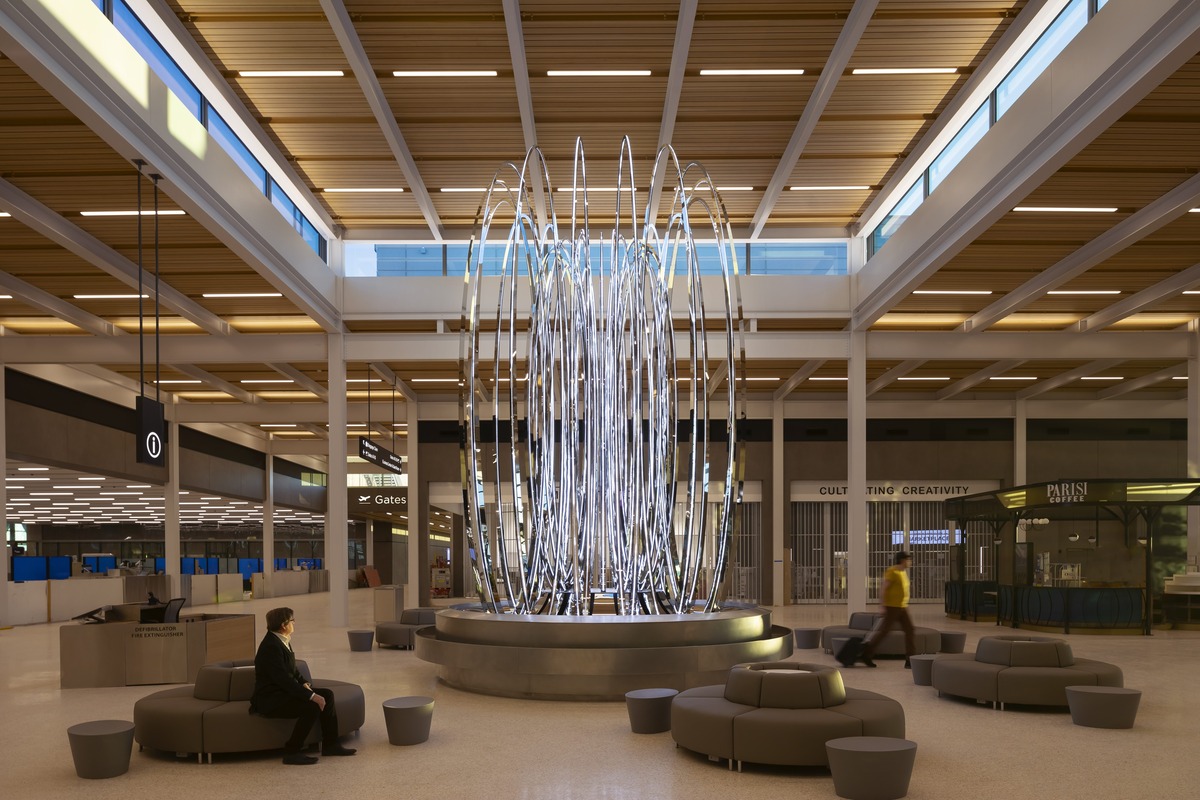
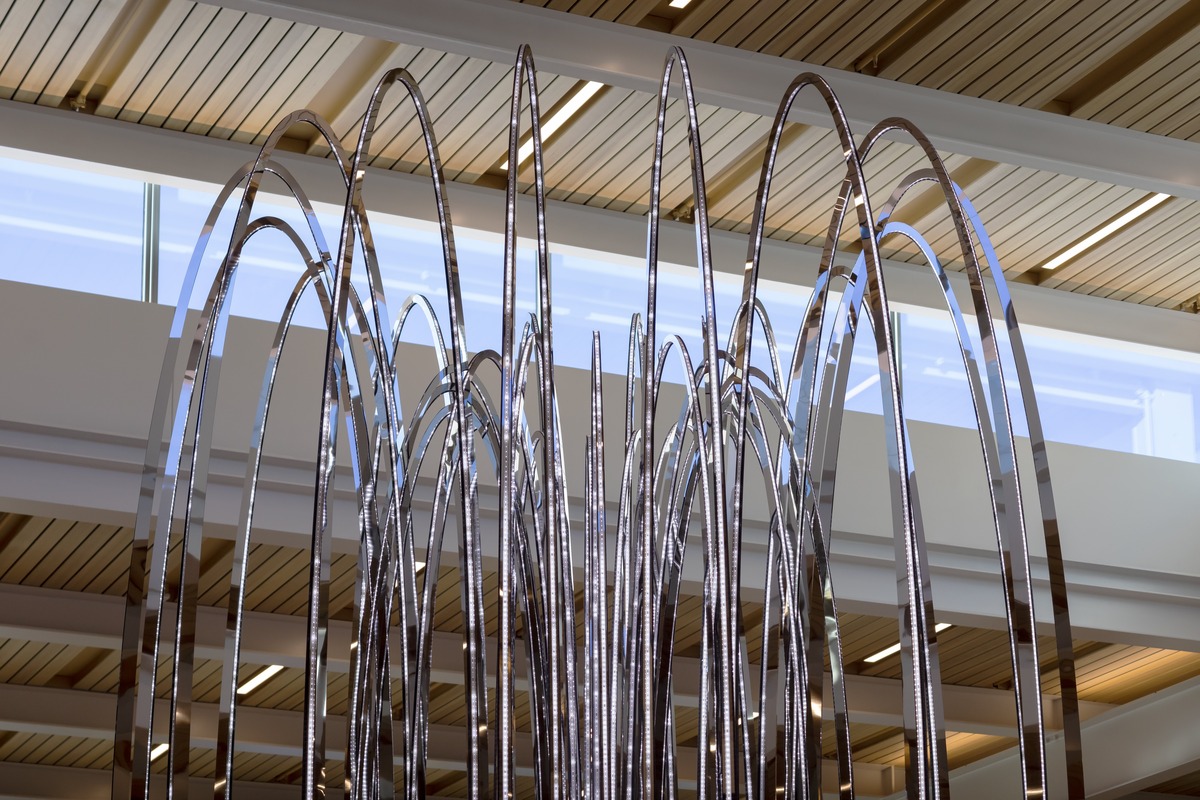
Your site-specific works have been displayed in various locations worldwide. How do you adapt your art to different environments and cultural contexts?
I recently completed a piece in Tokyo with Mori Building Co. for the new OMA designed Toranomon Hills Station Tower. It involved approximately six years of conversations and planning. Finally, I had the opportunity to go to Tokyo in September to work on the piece. For me, it was very exciting to witness people’s responses to the work. Most people, as they walked by, literally stopped to look at it as I was creating the sequences. It was amazing to see that happen and observe people’s reactions.
Did they ask you to do something specific, or do you work together to generate ideas? Do they provide guidelines, or did they give you complete freedom to create whatever you want?
It was a lengthy conversation with the architects, Shohei Shigematsu from OMA, and Mori. There were many proposals, visualizations, and a lot of back and forth, which was good. Eventually, we decided that the area above the entrance of the building would be activated. I worked on the sequencing, but I’ve always admired Japan and wanted to work there.
There was something that resonated with my interest in technology, early video games, and various cultural aspects. Being there as a foreigner made me realize that I could speak a universal language with code, and many people were excited about the piece in a way we could all understand, across cultural lines. It has been very successful, breaking down barriers through elements that go beyond language or images—just patterns and things we observe in nature.
Regarding your type of work, how do you balance control and unpredictability?
Engaging a lot of randomness and chance in some pieces, results in pieces that never display the exact same progression twice. It’s showing a set of sequences in a random order. Some earlier pieces are like that, and as my work evolved, there are many layers being randomized simultaneously. Now, I’m working in the realm of the generative, like Illuminated River in London. It’s generative, with nothing recorded, so the patterns are non-sequential, and the elements of randomization and chance lie within the artwork itself, which is exciting.
Certain sequences were created, and I made sure I had enough control to ensure the aesthetic as well as the functionality. It’s within specific parameters, and there are guardrails to give the algorithm some freedom while maintaining control. I’m not ready to hand over complete control to AI or other elements. I’m there as the author, working with randomness and chance, expressing my vision, but also open to moments of surprise within a certain range.
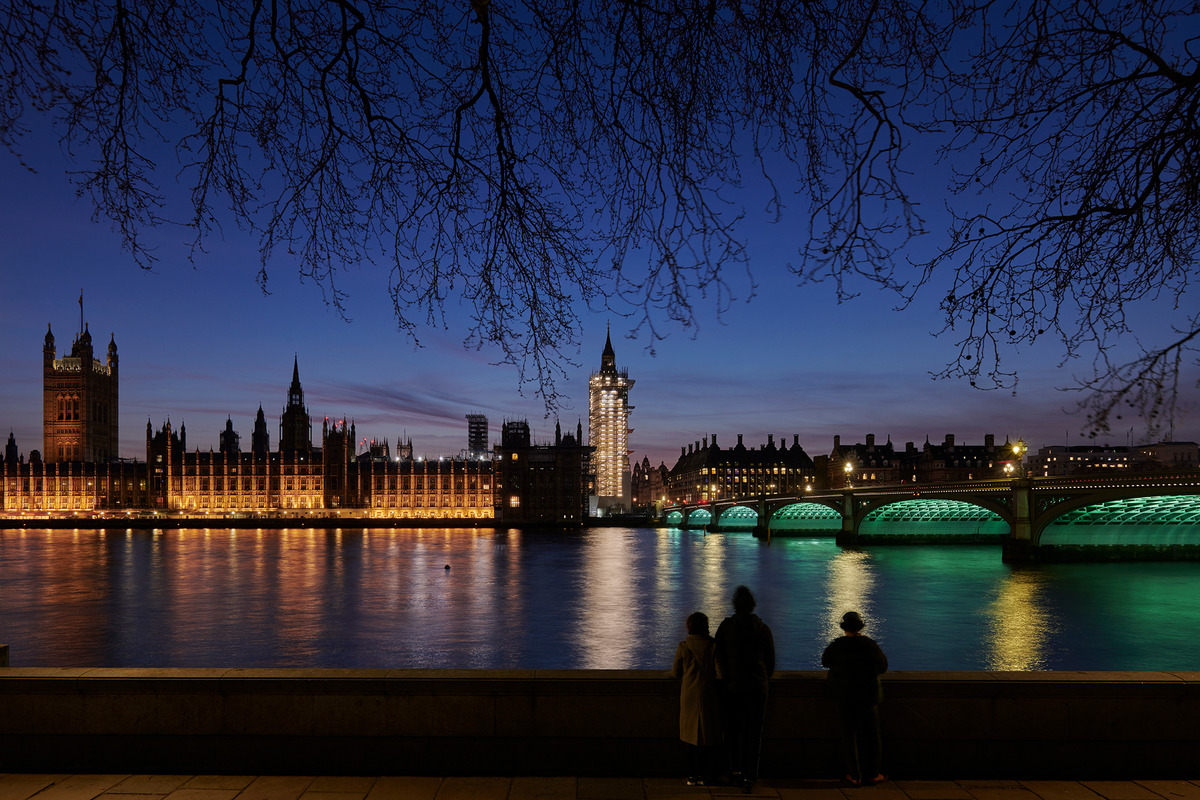
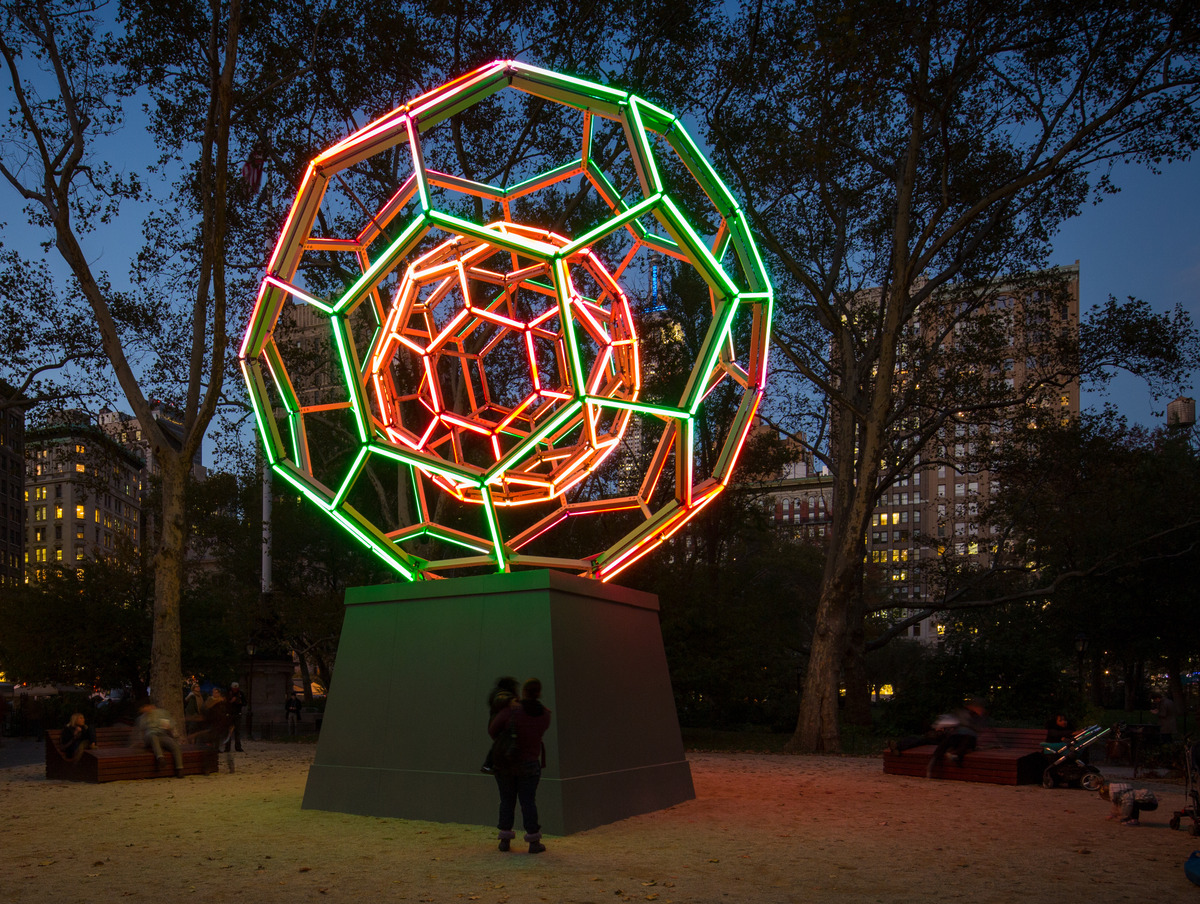
How has your artistic process evolved over the years, and are there any specific breakthrough moments that have shaped your trajectory?
I think the first public artwork I ever did was Supercluster at MOMA PS1 in 2003. I was asked by Alanna Heiss and Klaus Biesenbach to consider the building during the construction period. They wanted to create a light sculpture on the side of the building. This was an experiment, so we designed our own custom LED nodes and arranged them in a large array. The surprising moment for me was the response from the public. There was a gas station across the street on Jackson Avenue, and the attendant started talking about the lights, mentioning how they had shifted and the sequence had changed. It was interesting that people not in the museum were looking at the artwork, and those who didn’t necessarily know about art were having a response. I was very excited, realizing there was a huge audience in the world, and public art was important. That was one of the moments when I realized there was more to do in that space. Other significant moments with public art include The Bay Lights in San Francisco. The scale of it was immense. We made a documentary called “Impossible Light,” spanning 2.5 years from idea to installation. When I was first asked to think about the bridge as a canvas, I thought it would probably never happen. But after spending months working on a computer simulation, I created a one-minute animation, and it’s amazing how much the final artwork resembled that original idea. For something to come out of my brain, create it, and then realize it on the scale of the Bay Bridge—1.8 miles long and 525 ft tall—was a challenging process. We had no idea how difficult it would be, and despite facing various technical and logistical challenges, we made it happen. The Bay Bridge, often ignored as a utilitarian bridge compared to the beautiful Golden Gate, was transformed by adding these lights, shifting how people perceived it, and creating a contemplative space. My work at its core is about being present with others. The idea of communal experience is crucial, where everyone is engaged together in a group, and I aim to create experiences that take people on a journey. The complexity of the work adds to the richness of the type of art I pursue.
Now that you are an established artist and things flow organically, let’s reflect on the challenges you faced at the beginning of your career, given the complexity of your works.
Certainly, there was a lot of hustling, you know, because, when I first started using LEDs, they were very expensive and hard to access. I had to work hard to connect with those who were creating these technologies. The founders of a company called Color Kinetics, who were pioneers in this technology, were instrumental. They assisted me, offering deals on LEDs, providing access to extra products, and facilitating communication with their engineers to share insights on controlling lights with my own software.
Tapping into this DIY culture fascinated me, something I became familiar with at NYU in the nineties, where people engaged in ‘physical computing,’ voiding warranties and pushing the boundaries of technology creatively. Events like Burning Man introduced me to amazing technologists and further fostered a culture of generosity and sharing. Unlike the proprietary nature often seen in the default world, Burning Man offered a different ethos.
As an artist, the solution for me is to stay focused on my own work. I’ve been fortunate to build a strong team over time, starting by working alone to now having 11 people on my team. With multiple projects around the world, the scale of our work is demanding. However, it’s crucial to strike a balance between commercial projects and experimental endeavors driven by passion. Having what I might think of as my own research lab allows for creative exploration and experimentation which is thrilling.
Collaboration has been a significant part of your career. Could you please share a collaboration that had a profound impact on your creative journey?
I work collaboratively, particularly at Burning Man, where I’ve attended since 1994. I founded a camp in 2001, and for me, the joy lies in working collectively with the camp. It’s not solely about my individual work, but venturing into a space where the rules are different. This is so refreshing, allowing me to experiment more freely. It’s akin to adopting another identity, a process I find helpful and beneficial, considering I’ve devoted ample time to my individual projects.
Over the years, I’ve successfully collaborated with some of the world’s top architects. Often, we are dealing with strong opinions and attachment to a specific vision, but still, we’ve been able to develop a shared understanding of how to elevate a site through the value we bring to the project. This openness has allowed for fruitful collaborations, fostering a dynamic environment where more possibilities can unfold.
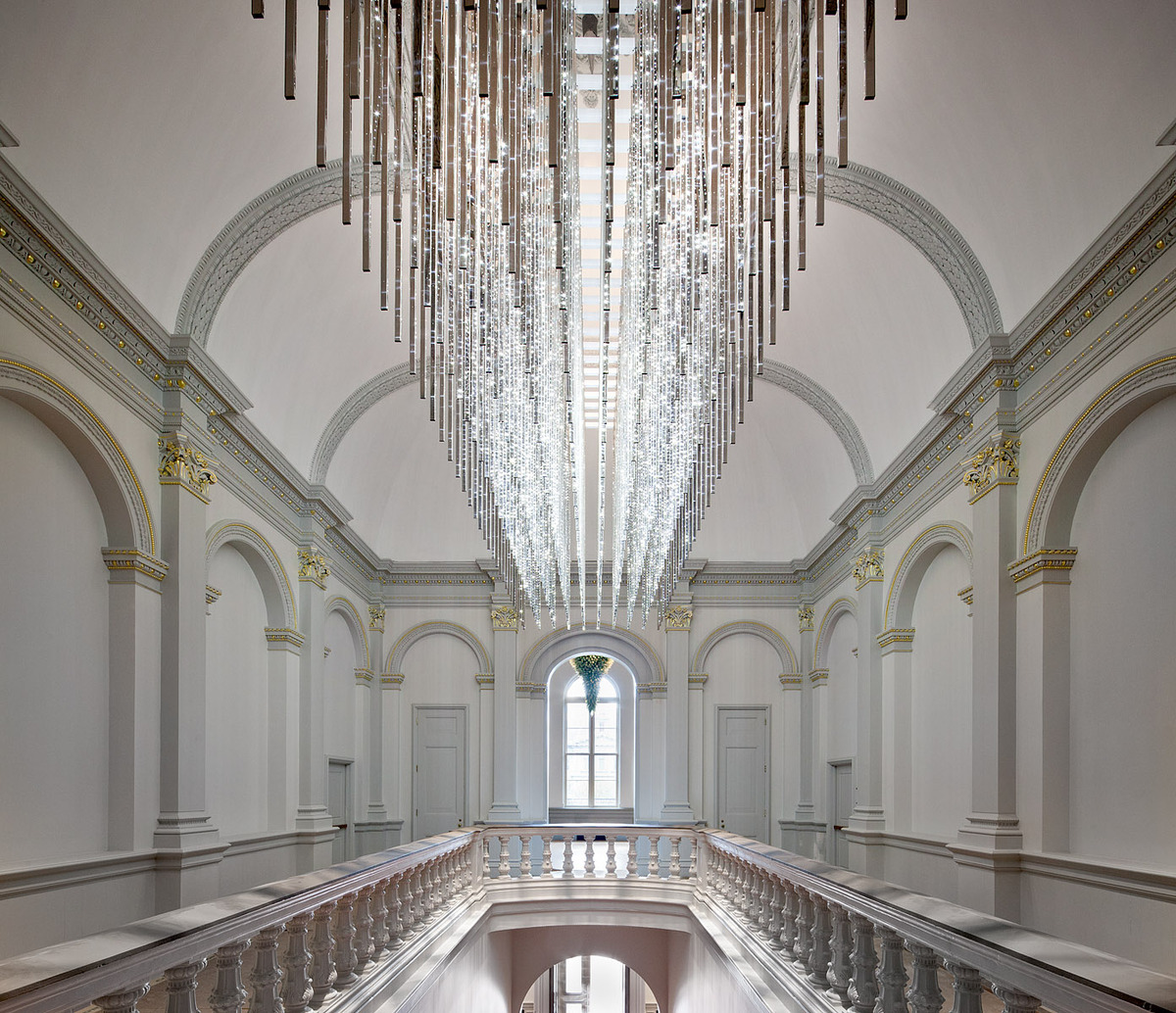
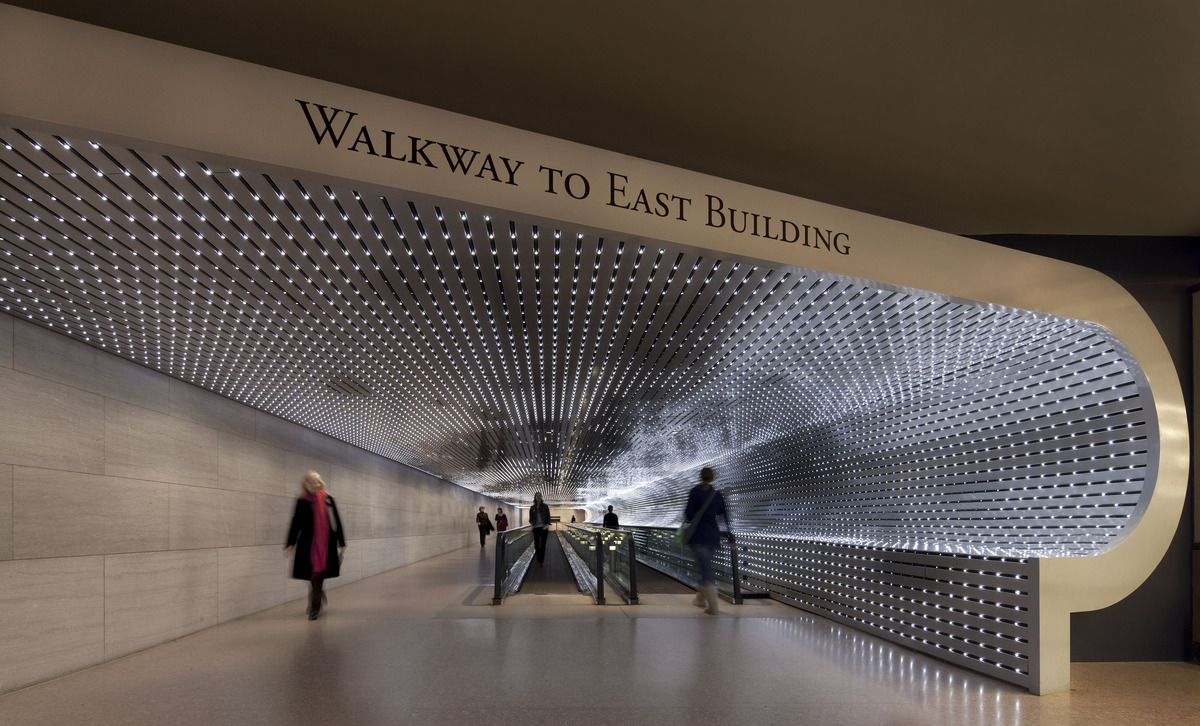
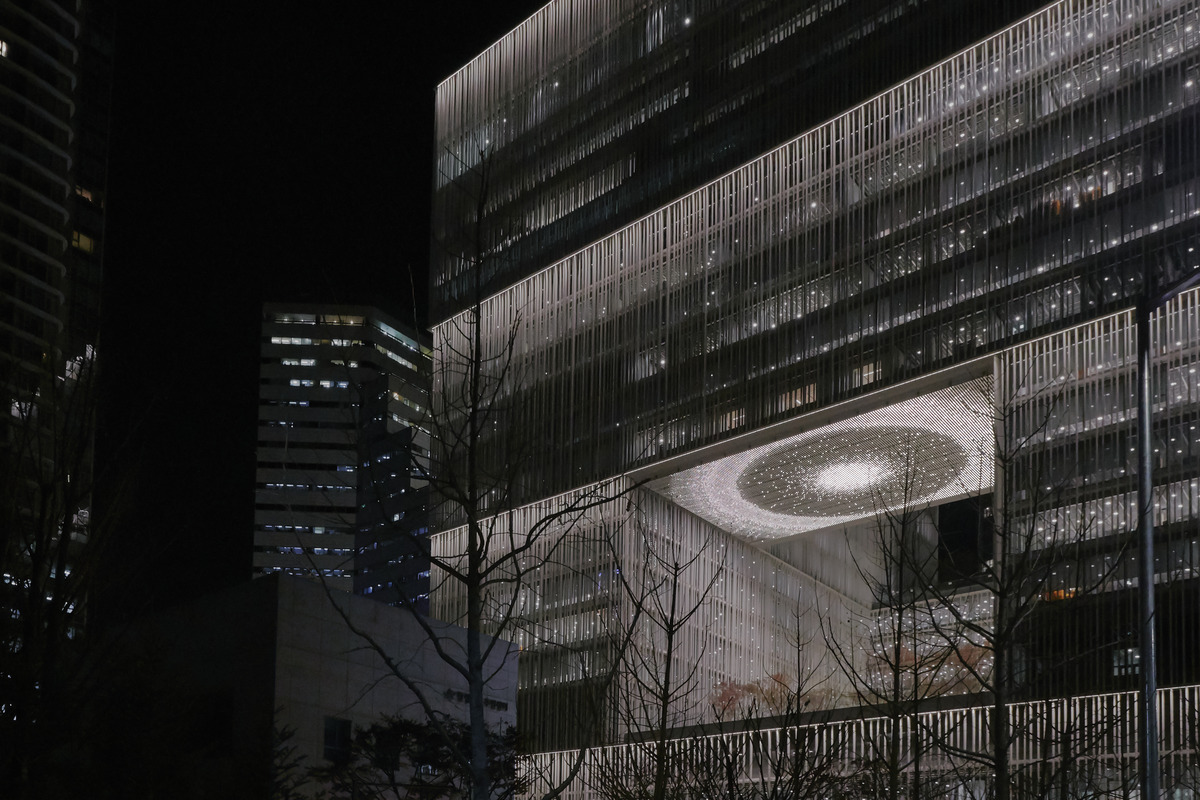
Are there any upcoming projects or concepts you’re excited to explore in your future work?
I am currently working on an artwork for the front of the El Paso Museum of Art. I grew up in El Paso and Juarez, right on the border. It’s interesting to create something in the place where you are from, and I believe it will be a captivating installation that activates the entrance to the museum. The border is an intriguing place, and many artists are contemplating it; I think it’s fertile territory for addressing contemporary societal issues. It truly is the front line. I spent my youth crossing the bridge over the Rio Grande daily. Living on the edge between Mexico and the United States, between two cultures, we saw it as one combined place. I would like to spend more time in Marfa, where my mother’s family has been cattle ranching since 1880. I love working in the urban landscape, but look forward to more engagement with nature in the future.
How do you envision the evolution of your digital and interactive art?
We love technology, and we couldn’t do what we do without it. We’re always exploring new displays, lasers, and screens, and we’re in touch with many companies who share their latest technology. We’re also exploring immersive experiences which can be powerful and transformative. Making generative art is intriguing, and I feel a connection to those who truly care about the art part of it, not about creating a commodity. I think once all this dust settles, out of the ashes could come something compelling. It would be fascinating to look back in five or 10 years and to see what emerges because it’s a pretty exciting mix right now.
All images courtesy of Leo Villareal Studio
Editor: Kristen Evangelista